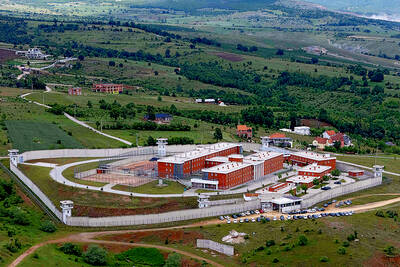Storms and flash floods turned roads into gushing rivers and swamped homes with waist-high muddy water across the Kenyan capital Nairobi on Wednesday, killing at least 10 people.
The East Africa region has been lashed by relentless downpours in recent weeks, as the El Nino weather pattern exacerbates the seasonal rainfall.
Across Nairobi, vehicles were stuck in the deluge and people waded through floodwaters in slum areas to reach safety.

Photo: AFP
“The number of bodies recovered so far are 10 and we have other people who are missing,” local police commander Fred Abuga said.
According to the Nairobi county governor’s office, an estimated 60,000 people, mostly women and children, have been “severely affected” by the floods.
The Kenya Meteorological Department said that “heavy to very heavy” rainfall was forecast in various parts of the country until next month.
In one incident on Wednesday, police fired tear gas to disperse angry residents who had blocked a main highway with long lines of cars calling for government action over the floods.
Kenya Railways announced it was temporarily suspending commuter train services, while the roads authority said four roads in the capital had been partly closed.
“The city is at a standstill because most roads are flooded,” Uber driver Kelvin Mwangi said. “We are having to use longer routes and in some cases we can’t get to our destination.”
Homes were engulfed in the sprawling Nairobi slum of Mathare, where residents took to rooftops to save their lives and belongings.
The Kenya Red Cross said it had rescued 18 people including seven children stranded in Mathare.
It posted a picture on X showing its workers, some waist-high in water, engaged in rescue efforts, as a man carried a young child on his shoulder.
In a dramatic rescue on Tuesday, Kenyan police said they had saved a five-year-old boy who had been marooned alone by floods in Machakos County, southeast of the capital.
The youngster had been left behind by his father as the waters rose and was airlifted to safety by chopper, the Kenyan National Police Service said on X.
The Red Cross said the Athi River, the second longest in Kenya that runs south of Nairobi to the Indian Ocean, had burst its banks, blocking roads and leaving residents stranded.
It said it had rescued 96 people in a town also named Athi River.
In downtown Nairobi where many government offices and the parliament are based, a main avenue was blocked by fallen trees.
“This rain is a disaster, and we fear it will be worse if it continues for two more days,” said Rosemary Okello, who owns a shop on the avenue.
Prominent opposition Senator Edwin Sifuna said the situation had “escalated to extreme levels” and that the county authorities were “clearly overwhelmed.”
“We need all national emergency services mobilised to save lives,” he said on X.
UN humanitarian agency OCHA on Friday last week said that the rains and floods had claimed the lives of at least 32 people in Kenya and displaced more than 40,000 since the start of the rainy season last month.
Elsewhere in the region, about 100,000 people have been displaced in Burundi, while at least 58 people have died in Tanzania and several thousand made homeless.
El Nino often has devastating consequences in East Africa, a region already hit by repeated climate shocks.
Late last year more than 300 people died in torrential rains and floods in Kenya, Somalia and Ethiopia.

Packed crowds in India celebrating their cricket team’s victory ended in a deadly stampede on Wednesday, with 11 mainly young fans crushed to death, the local state’s chief minister said. Joyous cricket fans had come out to celebrate and welcome home their heroes, Royal Challengers Bengaluru, after they beat Punjab Kings in a roller-coaster Indian Premier League (IPL) cricket final on Tuesday night. However, the euphoria of the vast crowds in the southern tech city of Bengaluru ended in disaster, with Indian Prime Minister Narendra calling it “absolutely heartrending.” Karnataka Chief Minister Siddaramaiah said most of the deceased are young, with 11 dead

DENIAL: Musk said that the ‘New York Times was lying their ass off,’ after it reported he used so much drugs that he developed bladder problems Elon Musk on Saturday denied a report that he used ketamine and other drugs extensively last year on the US presidential campaign trail. The New York Times on Friday reported that the billionaire adviser to US President Donald Trump used so much ketamine, a powerful anesthetic, that he developed bladder problems. The newspaper said the world’s richest person also took ecstasy and mushrooms, and traveled with a pill box last year, adding that it was not known whether Musk also took drugs while heading the so-called US Department of Government Efficiency (DOGE) after Trump took power in January. In a

By 2027, Denmark would relocate its foreign convicts to a prison in Kosovo under a 200-million-euro (US$228.6 million) agreement that has raised concerns among non-governmental organizations (NGOs) and residents, but which could serve as a model for the rest of the EU. The agreement, reached in 2022 and ratified by Kosovar lawmakers last year, provides for the reception of up to 300 foreign prisoners sentenced in Denmark. They must not have been convicted of terrorism or war crimes, or have a mental condition or terminal disease. Once their sentence is completed in Kosovan, they would be deported to their home country. In

LOST CONTACT: The mission carried payloads from Japan, the US and Taiwan’s National Central University, including a deep space radiation probe, ispace said Japanese company ispace said its uncrewed moon lander likely crashed onto the moon’s surface during its lunar touchdown attempt yesterday, marking another failure two years after its unsuccessful inaugural mission. Tokyo-based ispace had hoped to join US firms Intuitive Machines and Firefly Aerospace as companies that have accomplished commercial landings amid a global race for the moon, which includes state-run missions from China and India. A successful mission would have made ispace the first company outside the US to achieve a moon landing. Resilience, ispace’s second lunar lander, could not decelerate fast enough as it approached the moon, and the company has